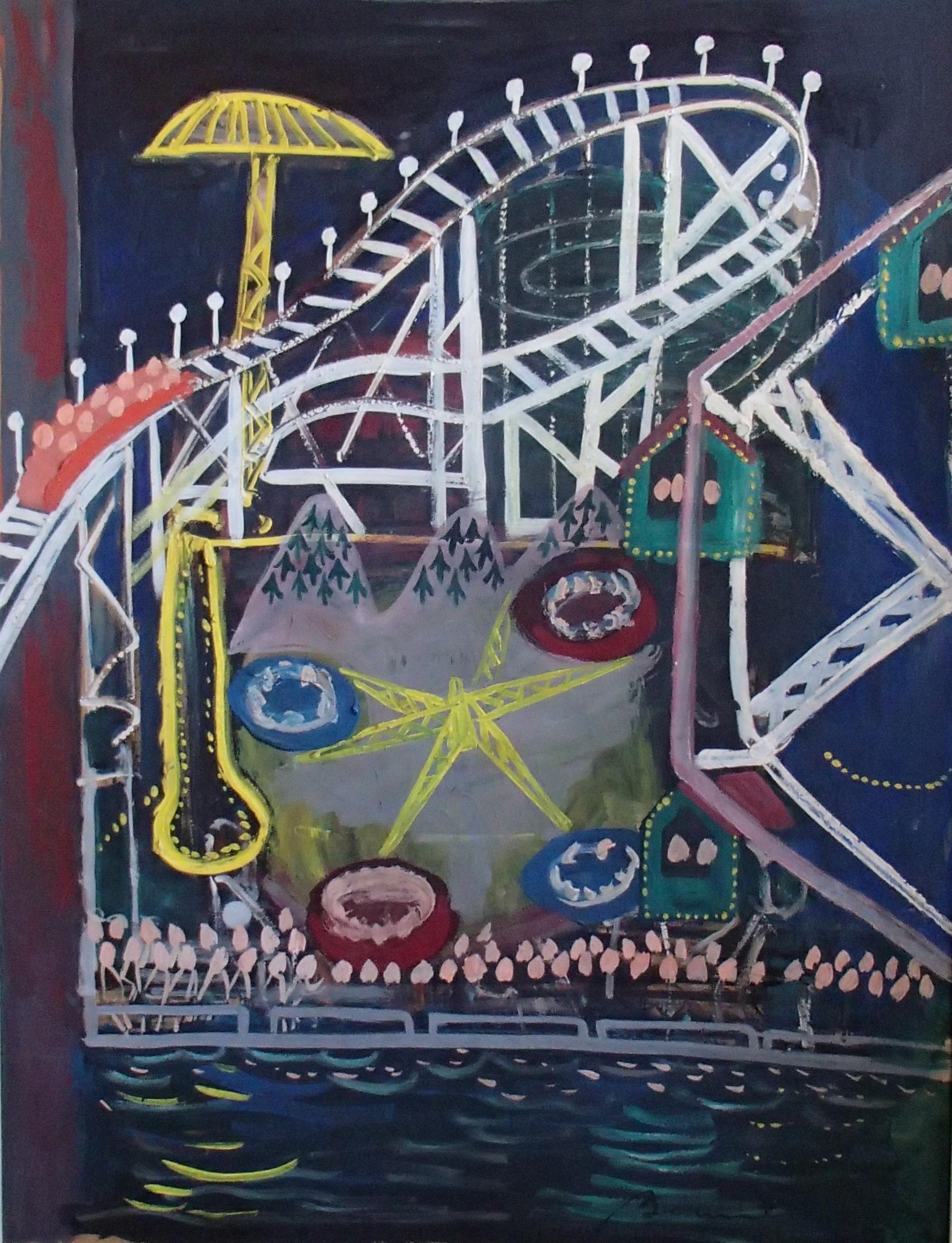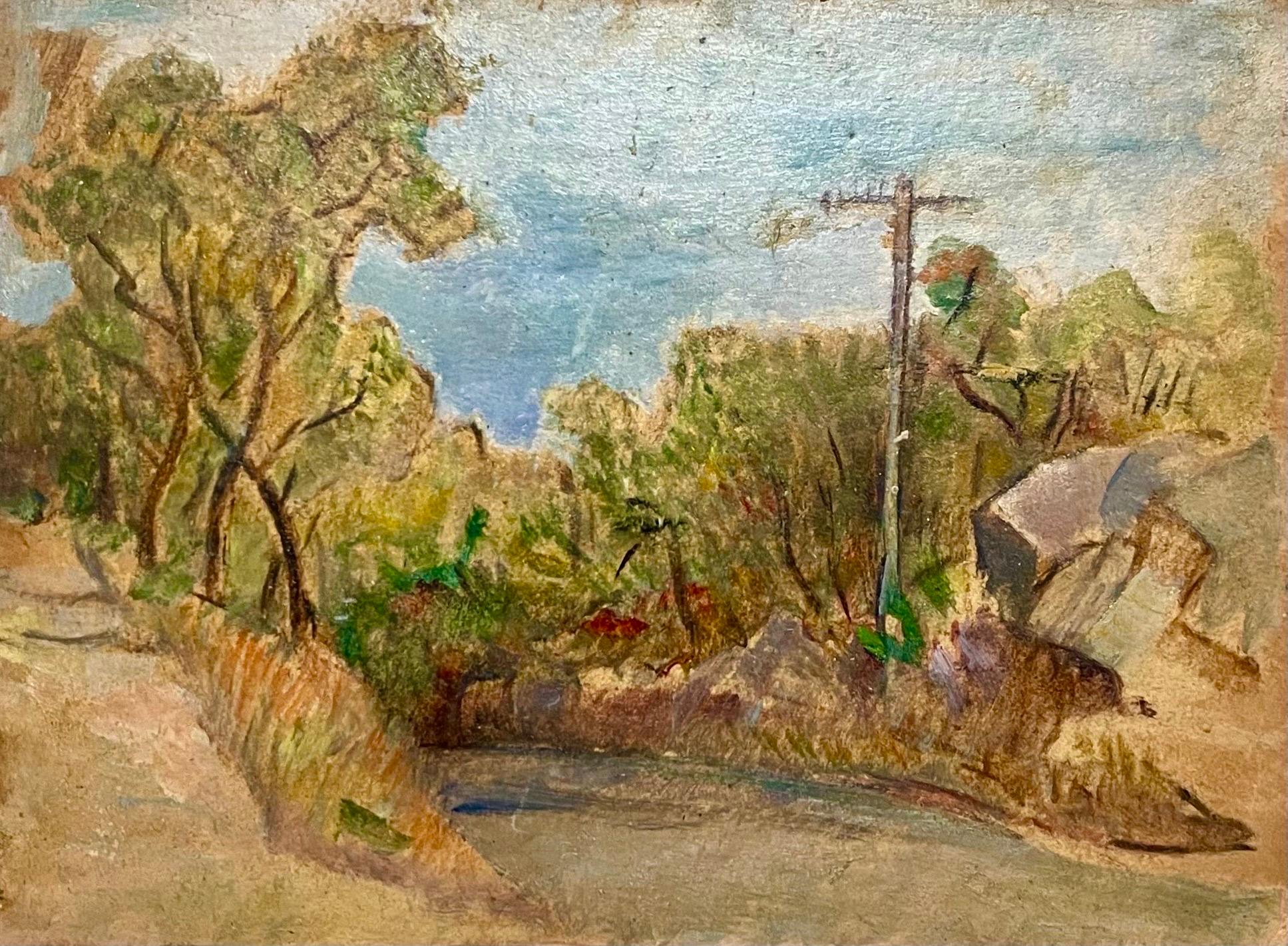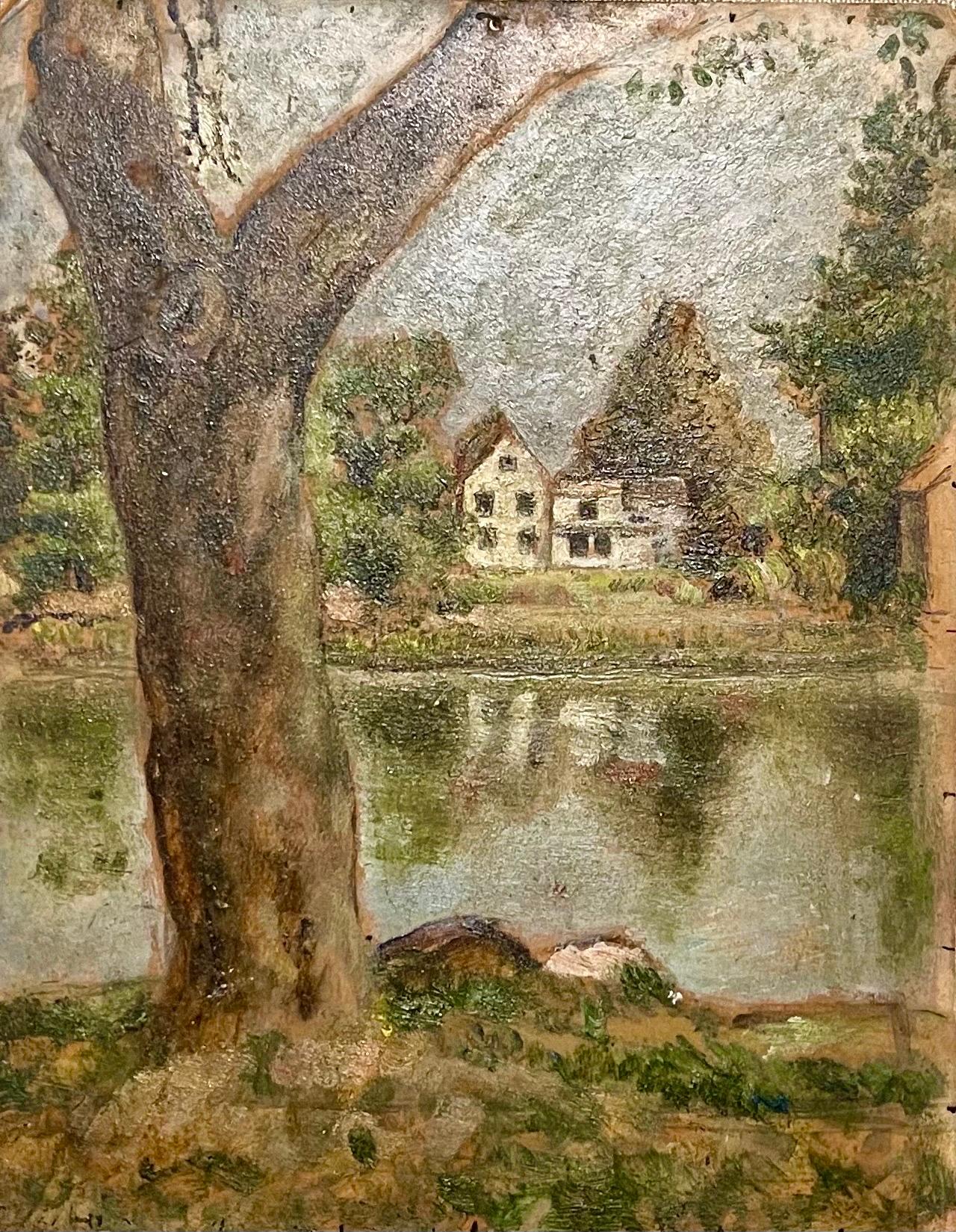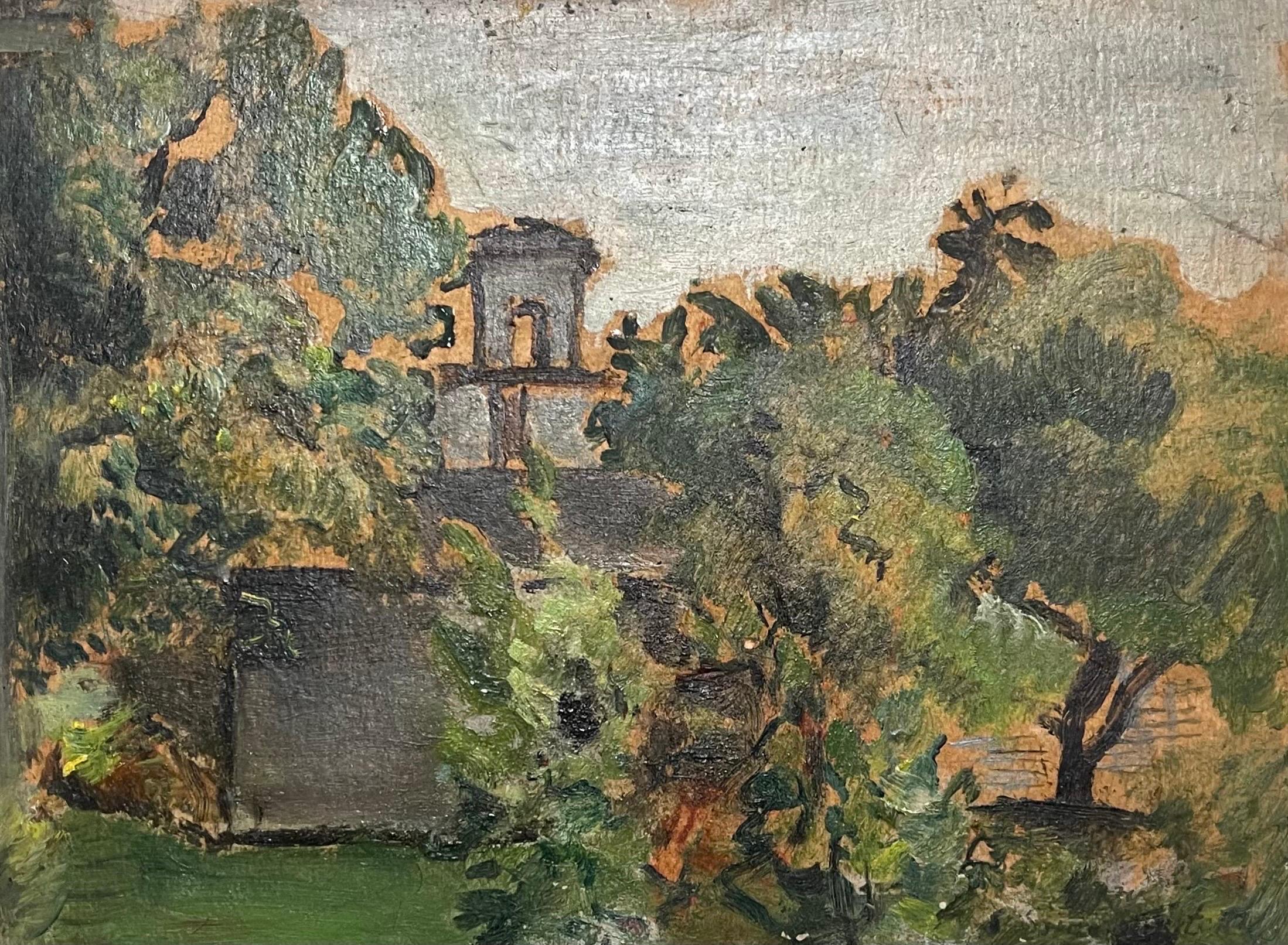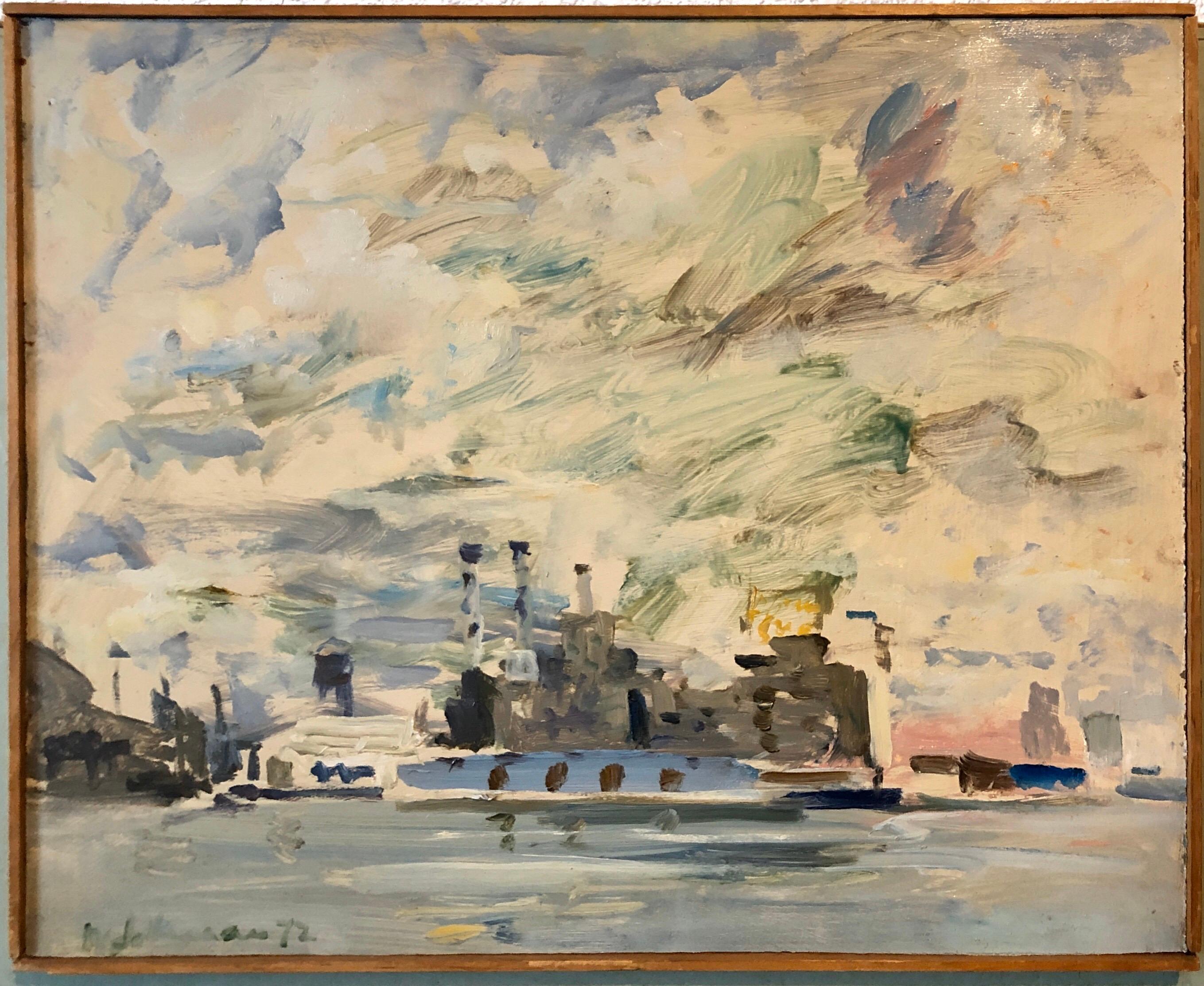Items Similar to My Only Working Tool
Want more images or videos?
Request additional images or videos from the seller
1 of 6
Fausto SansoneMy Only Working Tool1949
1949
About the Item
My Only Working Tool, 1949, oil on panel, signed and dated lower right, 16 x 12 inches, remnant of exhibition label verso, exhibited at the Art News Second Annual National Amateur Competition, National Academy of Design, New York, NY, December, 1950 (see The Best Amateurs, Art News, volume 49, issue 8, December 6 to 20, 1950, p. 65 – 66), presented in a period frame
Fausto Sansone was an accomplished untrained painter who lived in New York’s upper East Side. A native of Calabria, Italy, Sansone immigrated to the United States and became a naturalized citizen. He had a 4th grade education and worked his entire life as a suit-cutter and tailor, together with his older brother Salvatore. Sansone was one of the nation’s most accomplished amateur painters, having the present painting selected as one of only 150 artworks from nearly 1500 entries from around the country for the Art News' Second Annual National Amateur Competition at the National Academy of Design. The jury for this exhibition included some of America's most significant art leaders, including the artists, Josef Albers and Lorser Feitleson, and art critics, Margit Varga and Dorothy Adlow. About the competition, Albers remarked, "It was a very encouraging experience to see that many people are doing such serious and consistent work, and using their leisure time to develop a sensitive articulation in painting their vision and ideas. I wish I could show my students such work because of its originality and honesty and particularly because of the absence of the pretentiousness of the self-appointed genius." Speaking about Sansone's My only Working Tool, the Art News wrote, "Many of the paintings make eloquent comment on the lives and occupations of the artists. A tailor signifies his trade and perhaps also his rebellion against it by the way he paints his cutting shears on the window-sill high above New York’s Fourteenth Street." Perhaps Sansone was reflecting on his own identity being subsumed by his lifetime craft as his "only working tool" becomes a Magic Realist-inspired self-portrait.
- Creator:Fausto Sansone (1902 - 1995, American)
- Creation Year:1949
- Dimensions:Height: 16 in (40.64 cm)Width: 12 in (30.48 cm)Depth: 1 in (2.54 cm)
- More Editions & Sizes:16 x 12 inchesPrice: $4,250
- Medium:
- Movement & Style:
- Period:
- Condition:
- Gallery Location:Los Angeles, CA
- Reference Number:1stDibs: LU1859214266602
About the Seller
No Reviews Yet
Vetted Seller
These experienced sellers undergo a comprehensive evaluation by our team of in-house experts.
1stDibs seller since 2022
6 sales on 1stDibs
Typical response time: 2 hours
- ShippingRetrieving quote...Ships From: Los Angeles, CA
- Return PolicyA return for this item may be initiated within 3 days of delivery.
More From This SellerView All
- Untitled (Houses and Railroad Tracks)By Harry LaneLocated in Los Angeles, CAUntitled (Houses and Railroad Tracks), c. 1940s, oil on canvas board, signed lower right, 16 x 20 inches, presented in a newer frame This work is part of our exhibition America Coas...Category
1940s American Modern Paintings
MaterialsOil, Board
- Orange Grove LandscapeBy Dorr BothwellLocated in Los Angeles, CAOrange Grove Landscape, 1941, gouache on illustration board, 14 inches x 18 inches (image), 22 x 26 inches (framed) signed and dated lower right, newly framed with museum glazing ...Category
1940s American Modern Paintings
MaterialsGouache, Board
- Rabbit HuntersBy Roger MedearisLocated in Los Angeles, CARabbit Hunters, egg tempera on Masonite, 12 x 9 inches, 1947, signed and dated lower left, signed, titled and dated verso “Rabbit Hunters Egg Tempera Roger Medearis 1947,” exhibited ...Category
1940s American Modern Landscape Paintings
MaterialsTempera, Board
- LandscapeBy Marcel Emile CaillietLocated in Los Angeles, CALandscape, 1940, oil on canvas, 24 x 20 inches, signed, dated and titled verso: “Marcel Cailliet ’40 – S.C.” and “Marcel Cailliet Landscape”; likely exhibited at the annual juried st...Category
1940s American Modern Paintings
MaterialsCanvas, Oil
- Untitled (Collapsed Shacks)By Karl FortressLocated in Los Angeles, CAUntitled (Collapsed Shacks), c. 1940s, oil on canvas, signed lower left, 20 ½ x 26 ½ inches, presented in a period frame This work is part of our exhibition America Coast to Coast: ...Category
1940s American Modern Paintings
MaterialsCanvas, Oil
- Untitled (Farm in Winter)By Julius M. DelbosLocated in Los Angeles, CAThis work is part of our exhibition America Coast to Coast: Artists of the 1940s Untitled (Farm in Winter), 1940s, oil on canvas, signed lower right, 26 x 30 inches, presented in an original frame Julius Delbos...Category
1940s American Modern Paintings
MaterialsCanvas, Oil
You May Also Like
- "Coney Island" Brooklyn NYC Amusement Park Mid-century American Scene WPA ModernBy Ludwig Bemelmans, 1898-1962Located in New York, NY"Coney Island" Brooklyn NYC Amusement Park Mid-century American Scene WPA Modern Ludwig Bemelmans (1898 – 1962), “Coney Island" 35 x 27 inches Oil on board Signed lower left Origin...Category
1940s American Modern Landscape Paintings
MaterialsOil, Board
- Simka Simkhovitch WPA Artist Oil Painting Gouache American Modernist PowerlineBy Simka SimkhovitchLocated in Surfside, FLSimka Simkhovitch (Russian/American 1893 - 1949) This came with a small grouping from the artist's family, some were hand signed some were not. These were studies for larger paintings. Simka Simkhovitch (Симха Файбусович Симхович) (aka Simka Faibusovich Simkhovich) (Novozybkov, Russia May 21, 1885 O.S./June 2, 1885 N.S.—Greenwich, Connecticut February 25, 1949) was a Ukrainian-Russian Jewish artist and immigrant to the United States. He painted theater scenery in his early career and then had several showings in galleries in New York City. Winning Works Progress Administration (WPA) commissions in the 1930s, he completed murals for the post offices in Jackson, Mississippi and Beaufort, North Carolina. His works are in the permanent collections of the Dallas Museum of Art, the National Museum of American Art and the Whitney Museum of American Art. Born outside Kyiv (Petrograd Ukraine) into a Jewish family who owned a small department store. During a severe case of measles when he was seven, Simcha Simchovitch sketched the views outside his window and decided to become an artist, over his father's objections. Beginning in 1905, he studied at the Grekov Odessa Art School and upon completion of his studies in 1911 received a recommendation to be admitted to the Imperial Academy of Arts. Though he enrolled to begin classes in architecture, painting, and sculpture at the Imperial Academy, he was dropped from the school roster in December because of the quota on the number of Jewish students and drafted into the army. Simchovitch served as a private in the 175th Infantry Regiment Baturyn [ru] until his demobilization in 1912. Re-enrolling in the Imperial Academy, he audited classes. Simka Simkhovitch exhibited paintings and sculptures in 1918 as part of an exhibition of Jewish artists and in 1919 placed 1st in the competition "The Great Russian Revolution" with a painting called "Russian Revolution" which was hung in the State Museum of Revolution. In 1922, Simkha Simkhovitch exhibited at the International Book Fair in Florence (Italian: Fiera Internazionale del Libro di Firenze). In 1924, Simkhovitch came to the United States to make illustrations for Soviet textbooks and decided to immigrate instead. Initially he supported himself by doing commercial art and a few portrait commissions. In 1927, he was hired to paint a screen for a scene in the play "The Command to Love" by Fritz Gottwald and Rudolph Lothar which was playing at the Longacre Theatre on Broadway. Art dealers began clamoring for the screen and Simkhovitch began a career as a screen painter for the theater. Catching the attention of the screenwriter, Ernest Pascal, he worked as an illustrator for Pascal, who then introduced him to gallery owner, Marie Sterner. Simkhovitch's works appeared at the Marie Sterner Gallery beginning with a 1927 exhibit and were repeated the following year. Simkhovitch had an exhibit in 1929 at Sterner's on circus paintings. In 1931, he held a showing of works at the Helen Hackett Gallery, in New York City and later that same year he was one of the featured artists of a special exhibit in San Francisco at the California Palace of the Legion of Honor in Lincoln Park. The exhibit was coordinated by Marie Sterner and included four watercolors, including one titled "Nudes". He is of the generation of Russian Soviet artists such as Isaac Pailes, Serge Charchoune, Marc Chagall, Chana Orloff, Isaac Ilyich Levitan, and Ossip Zadkine. In 1936, Simkhovitch was selected to complete the mural for the WPA Post office project in Jackson, Mississippi. The mural was hung in the post office and courthouse in 1938 depicted a plantation theme. Painted on the wall behind the judge’s bench, “Pursuits of Life in Mississippi”, a depiction of black workers engaged in manual labor amid scenes of white professionals and socialites, was eventually covered over in later years during renovations due to its stereotypical African American imagery. Simka painted what he thought was typical of Jackson. His impression of pre-civil rights Mississippi was evidently Greek Revival column houses, weeping willow trees, working class families, and the oppression of African Americans. He painted African American men picking cotton, while a white man took account of the harvest and a white judge advised a white family, calling it Pursuits of Life in Mississippi. Though clearly endorsed by the government and initially generally well-received, the mural soon raised concerns with locals as the climate toward racial segregation began to change. The main concern was whether depictions that show African Americans in subjugated societal roles should be featured in a courtroom. The following year, his painting "Holiday" won praise at an exhibition in Lincoln, Nebraska. In 1940, Simkhovitch's second WPA post office project was completed when four murals, "The Cape Lookout Lighthouse and the Orville W. Mail Boat", "The Wreck of the Crissie Wright", "Sand Ponies" and "Canada Geese" were installed in Beaufort, North Carolina. The works were commissioned in 1938 and did not generate the controversy that the Jackson mural had. The main mural is "The Wreck of the Crissie Wright" and depicts a shipwreck which had occurred in Beaufort in 1866. "The Cape Lookout Lighthouse and the Orville W. Mail Boat" depicted the lighthouse built in 1859 and the mail boat that was running mail during the time which Simkhovitch was there. The boat ran mail for the area until 1957. "Sand Ponies" shows the wild horses common to the North Carolina barrier islands and "Canada Geese" showed the importance of hunting and fishing in the area. All four murals were restored in the 1990s by Elisabeth Speight, daughter of two other WPA muralists, Francis Speight...Category
1930s American Modern Landscape Paintings
MaterialsGouache, Oil, Board
- Simka Simkhovitch WPA Artist Oil Painting American Modernist Landscape Pond TreeBy Simka SimkhovitchLocated in Surfside, FLSimka Simkhovitch (Russian/American 1893 - 1949) This came with a small grouping from the artist's family, some were hand signed some were not. Thes...Category
1930s American Modern Landscape Paintings
MaterialsOil, Board
- Simka Simkhovitch WPA Artist Oil Painting American Modernist Landscape w TowerBy Simka SimkhovitchLocated in Surfside, FLSimka Simkhovitch (Russian/American 1893 - 1949) This came with a small grouping from the artist's family, some were hand signed some were not. Thes...Category
1930s American Modern Landscape Paintings
MaterialsOil, Board
- 1972 Gestural Oil Painting Boat in Harbor Figural Abstraction Raoul MiddlemanBy Raoul MiddlemanLocated in Surfside, FLRaoul Middleman (born 1935 in Baltimore, Maryland) is an American painter. Middleman has been a member of the Maryland Institute College of Art faculty since 1961. American University Museum at the Katzen Center has described Middleman as a "Baltimore maestro [whose] nudes are not pretty—they are sagging, dimpled, and real. His cityscapes reveal the underbelly of post-industrial rot, his narrative paintings give contemporary life to his personal obsessions. They are intelligent, messy, and utterly masterful." From an interview with RM "I was doing abstract art. Then Roy Lichtenstein came around, and I wanted to be current. I remember Grace Hartigan said, “You’ve gotta go to New York, seize destiny by the hand.” My friend Jon Schueler took my slides up to Eleanor Ward, who had the Stable Gallery. My Pop art paintings were discovered. I moved to New York into Malcolm Morley’s old loft down on South Street. Agnes Martin was upstairs... People who interest me come from different quarters. I knew guys around Schueler, like B.H. Friedman. But I also knew the Pop world pretty well – Al Hansen, Richard Artschwager, Lichtenstein. I became friends with Raoul Hague and I rented a place in Port Jervis, New York. I started doing my first landscapes up there. I thought making landscapes was the dumbest thing you could do. You got flies, insects, cow pies, humidity. But I loved it... I went down to the meetings of the Figurative Alliance. I met my friends there — Paul Resika, Paul Georges, Rosemarie Beck...Category
1970s American Modern Landscape Paintings
MaterialsOil, Board
- Bathers at the Quarry 1940s American Modernist Oil Painting WPA eraBy Theresa Berney LoewLocated in Surfside, FLSwimmers and sun tanners at the local watering hole. Her birth name was Theresa Berney. At the time of her passing she was known as Theresa Loew. Birth place: Baltimore artist, blo...Category
1940s American Modern Landscape Paintings
MaterialsOil, Board
